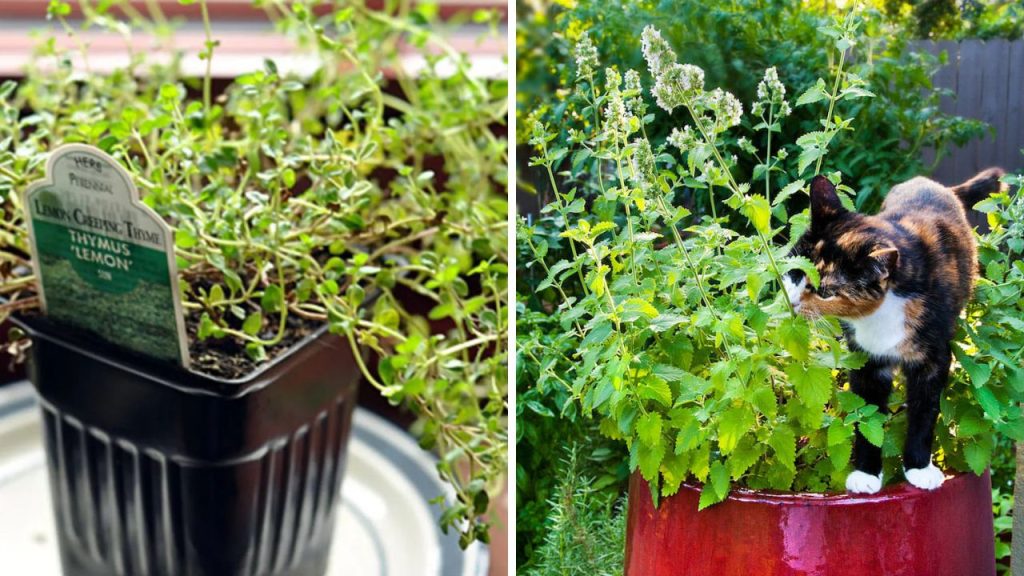Rainscaping is an innovative approach to landscaping that emphasizes the sustainable management of rainwater runoff. As more homeowners seek to create beautiful, eco-friendly outdoor spaces, rainscaping has gained popularity for its dual benefits: enhancing the aesthetics of your yard while promoting environmental responsibility. This article presents 17 inspiring rainscaping ideas, perfect for homeowners looking to improve their gardens while also doing their part for the planet.
In this first part, we’ll explore the first 10 ideas, each designed to help you manage rainwater more effectively and beautifully. Let’s dive in!
1. Install a Charming Rain Garden
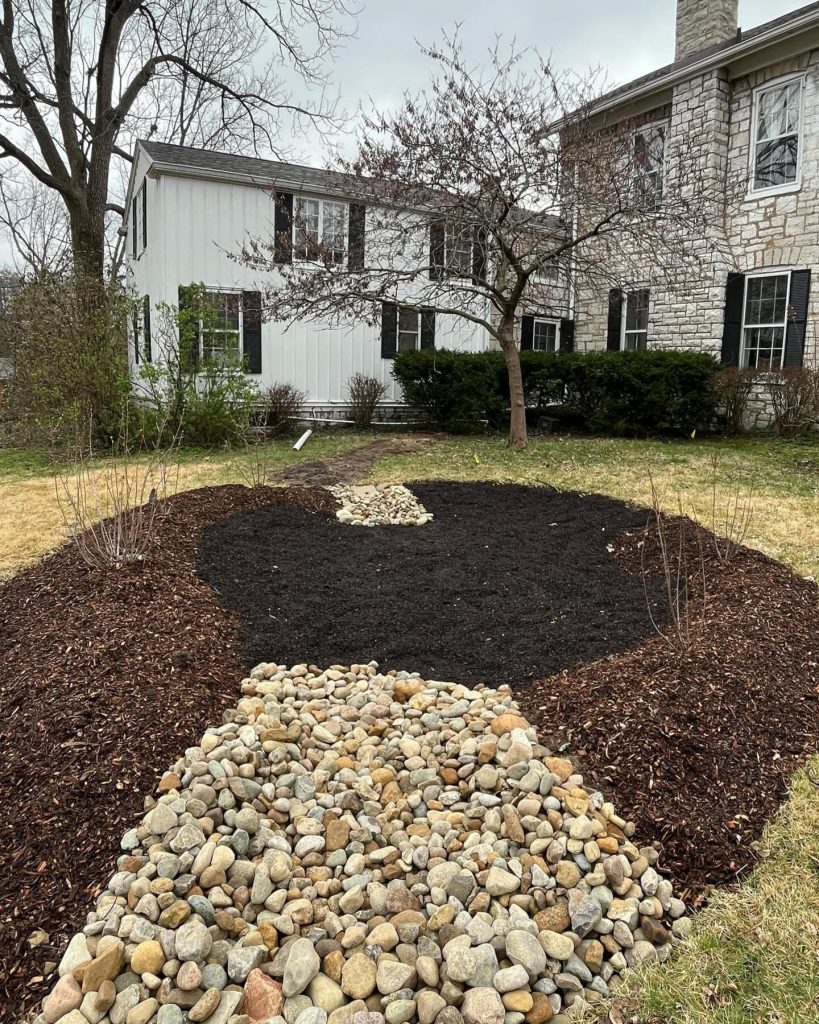
Rain gardens are designed to capture and absorb rainwater from roofs, driveways, and other hard surfaces. These shallow, planted depressions are not only functional but can also be visually stunning when filled with native plants and flowers. A rain garden’s natural filtration system improves water quality by allowing rainwater to soak into the ground rather than flow into storm drains.
To create a rain garden, choose a location with good drainage that can collect runoff. Then, select a mix of native plants that thrive in wet and dry conditions. Consider incorporating colorful perennials, ornamental grasses, and flowering shrubs to create visual interest. Additionally, a rain garden can attract beneficial wildlife, such as butterflies and birds, providing a lively and engaging outdoor experience.
Rain gardens can vary in size, making them adaptable to any yard. Whether you have a spacious landscape or a cozy backyard, a rain garden can enhance the beauty and functionality of your home while promoting sustainability.
2. Use a Decorative Rain Barrel
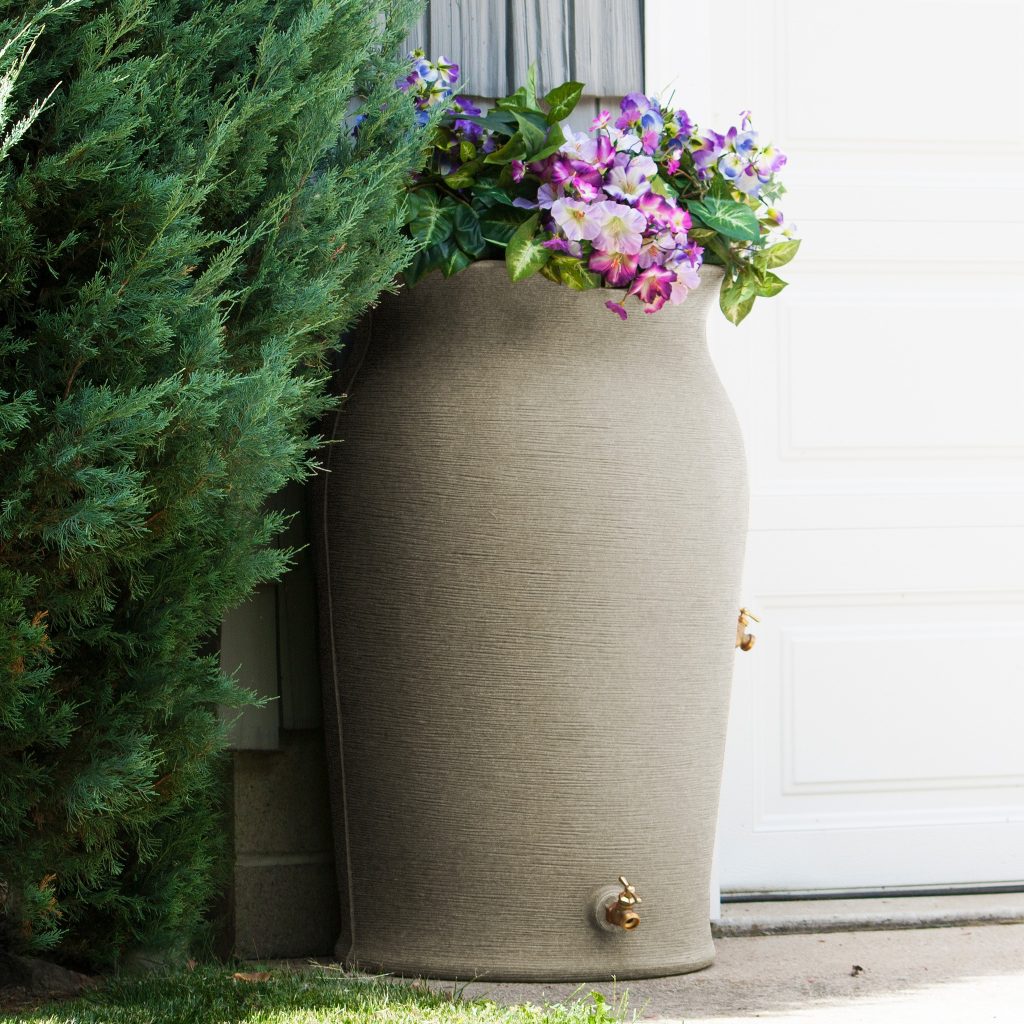
Rain barrels are an excellent way to collect rainwater from your roof, allowing you to reuse it for watering plants and gardens. However, they can be more than just practical; they can also serve as decorative elements in your landscape. With various styles and colors available, you can easily find a rain barrel that complements your home’s exterior and outdoor decor.
To create a rain barrel setup, position the barrel under a downspout to capture rainwater efficiently. You can paint the barrel to match your outdoor aesthetic or choose one with a decorative design. Adding a spigot at the bottom makes it easy to access the collected water. You might even consider incorporating a small fountain or water feature with your rain barrel to enhance its beauty and functionality.
By using a rain barrel, you not only reduce water waste but also help protect your local waterways from stormwater runoff. It’s an eco-friendly choice that contributes to a sustainable landscape while adding charm to your yard.
3. Create a Dry Creek Bed

Dry creek beds are a visually appealing way to manage excess water in your yard. This landscaping feature mimics the natural flow of a river or stream, channeling rainwater away from your home while adding a unique design element to your outdoor space. A dry creek bed is typically lined with rocks and gravel, allowing water to flow through while preventing erosion.
To construct a dry creek bed, start by determining the natural path of water flow in your yard. Dig a shallow trench that follows this path, then line it with landscaping fabric to prevent weeds from growing. Fill the trench with a mix of rocks, pebbles, and gravel in various sizes to create a natural look. Incorporate native plants and decorative stones along the edges for added visual interest.
A dry creek bed not only helps with drainage but also serves as an attractive landscaping feature that enhances the overall beauty of your yard. It can be particularly effective in areas prone to flooding or standing water.
4. Add Permeable Pavers to Pathways and Driveways
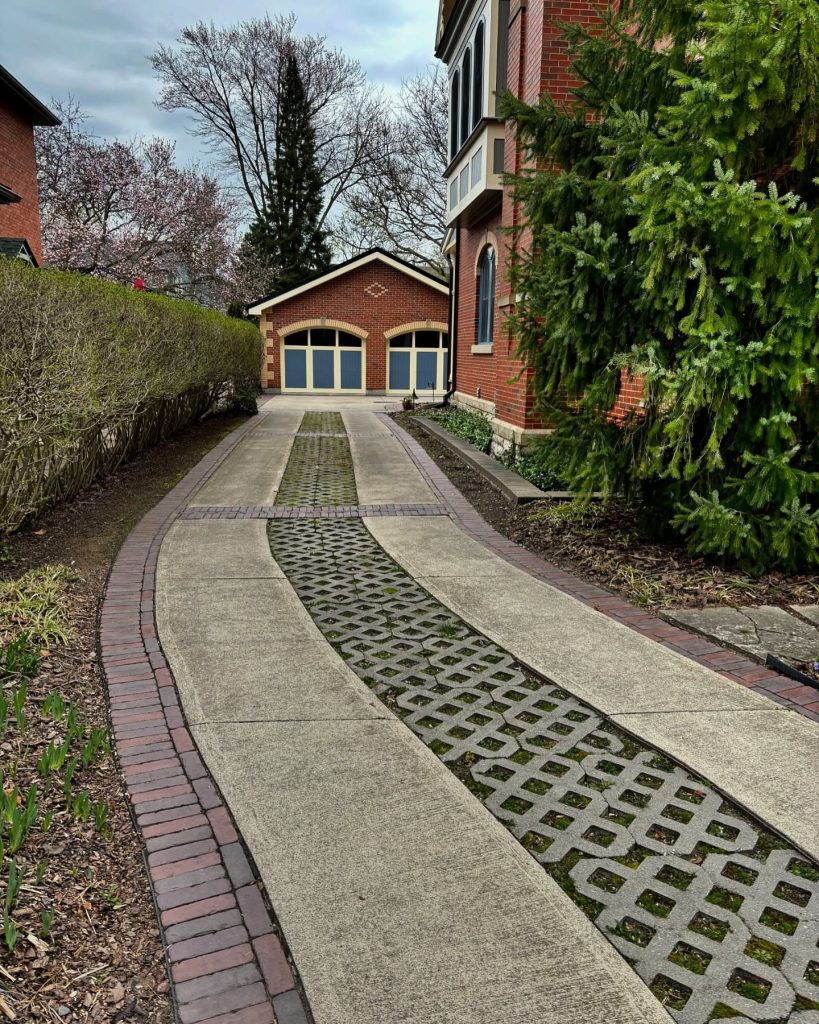
Permeable pavers are an excellent solution for homeowners looking to reduce runoff and promote better drainage. These specially designed pavers allow rainwater to seep through their surfaces, reducing the amount of water that flows into storm drains and minimizing the risk of flooding. Additionally, permeable pavers can be used in various outdoor applications, from walkways to patios.
When selecting permeable pavers, choose materials that blend well with your landscape design. You can opt for traditional brick or concrete pavers with gaps that allow water to pass through, or consider permeable asphalt for larger driveways.
The installation process involves laying the pavers in a way that creates gaps filled with gravel or sand, promoting effective water drainage. This not only enhances the functionality of your outdoor space but also adds a modern touch to your landscaping.
By using permeable pavers, you can create beautiful outdoor pathways and driveways while protecting the environment and managing rainwater runoff effectively.
5. Design a Swale with a Twist
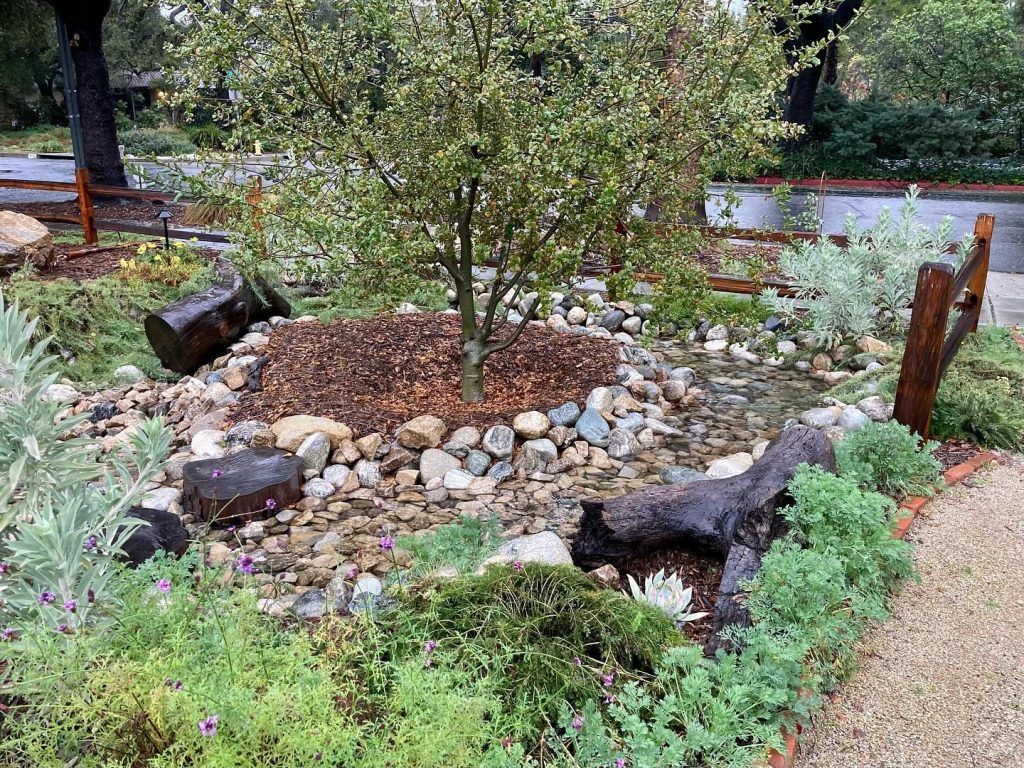
A swale is a shallow, landscaped ditch designed to manage stormwater runoff by directing it away from structures and into designated areas. However, swales don’t have to be purely functional; they can also be beautifully designed to enhance your landscape. By incorporating plants, decorative stones, and even seating areas, you can transform a standard swale into a lovely garden feature.
To create a swale, start by identifying the areas where water tends to collect in your yard. Dig a gentle slope that directs water away from your home, then line the bottom with landscaping fabric to prevent weeds. Add a mix of native plants that thrive in wet conditions, such as ferns and sedges, for a lush, green appearance.
Consider adding decorative stones or boulders along the edges of the swale for visual interest. A seating area with benches or chairs can also provide a cozy spot to relax while enjoying your garden’s beauty.
With a little creativity, a swale can serve both as a practical drainage solution and an attractive landscaping element.
6. Incorporate a Rainwater Harvesting System

Rainwater harvesting systems are an effective way to collect and store rainwater for later use. These systems can range from simple rain barrels to more complex setups that involve larger tanks and filtration systems. By capturing rainwater, you can reduce your dependence on municipal water sources and create a more sustainable landscape.
To set up a rainwater harvesting system, start by assessing your yard’s drainage patterns and the best locations for your tanks. Connect gutters and downspouts to the storage tanks, ensuring they are equipped with filters to keep debris out of the water.
You can choose aesthetically pleasing tanks that blend seamlessly into your landscape or even hide them with plantings. Utilize the harvested rainwater for irrigation, outdoor cleaning, and even indoor non-potable uses, such as flushing toilets.
Investing in a rainwater harvesting system not only benefits your garden but also contributes to conserving water resources, making it a responsible and attractive addition to any home.
7. Add a Rain Chain Instead of a Downspout
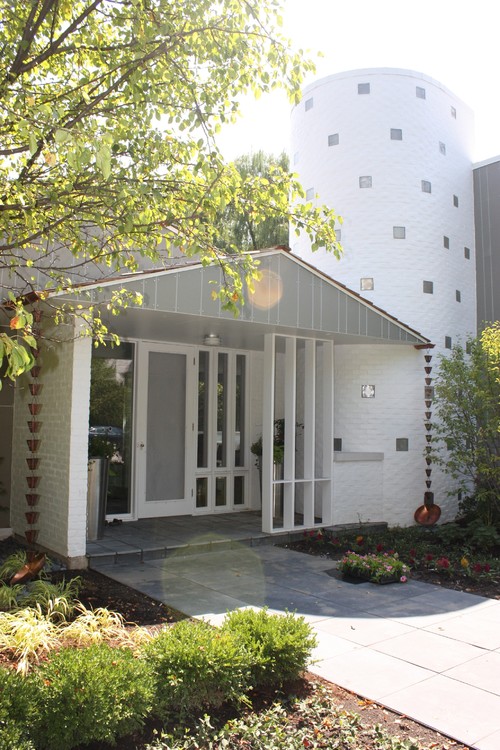
Rain chains are a beautiful alternative to traditional downspouts, allowing rainwater to flow from your roof to the ground in a visually appealing way. These decorative elements can create a soothing sound as water trickles down, adding a serene ambiance to your outdoor space. Rain chains come in various styles and materials, making them a versatile option for enhancing your garden.
To install a rain chain, simply replace your downspout with the chain, ensuring it directs water to a garden or decorative basin below. You can choose from various designs, including those made of copper, aluminum, or even ceramic, to complement your home’s aesthetic.
Consider placing a rain garden or basin at the bottom of the chain to collect the water and encourage plant growth. Rain chains not only manage rainwater effectively but also serve as an artistic element in your landscaping, making them a popular choice for eco-conscious homeowners.
8. Build a Living Roof on a Shed or Structure

Living roofs, also known as green roofs, are a unique way to manage rainwater while creating an eco-friendly and visually stunning feature on your property. A living roof is a layer of vegetation planted on the roof of a structure, allowing rainwater to be absorbed and filtered naturally. This practice helps reduce runoff, improves insulation, and creates habitats for wildlife.
To create a living roof, choose a structure that can support the additional weight of soil and plants. Begin with a waterproof membrane, followed by a drainage layer, soil, and then a selection of hardy, drought-resistant plants.
Incorporate a mix of flowering plants, sedums, and grasses for color and texture. Living roofs are not only functional but can also be a relaxing retreat for birds and butterflies, transforming an ordinary shed into a vibrant ecosystem.
Investing in a living roof is a beautiful way to improve your landscape while promoting biodiversity and sustainability.
9. Add a Pollinator-Friendly Rain Border
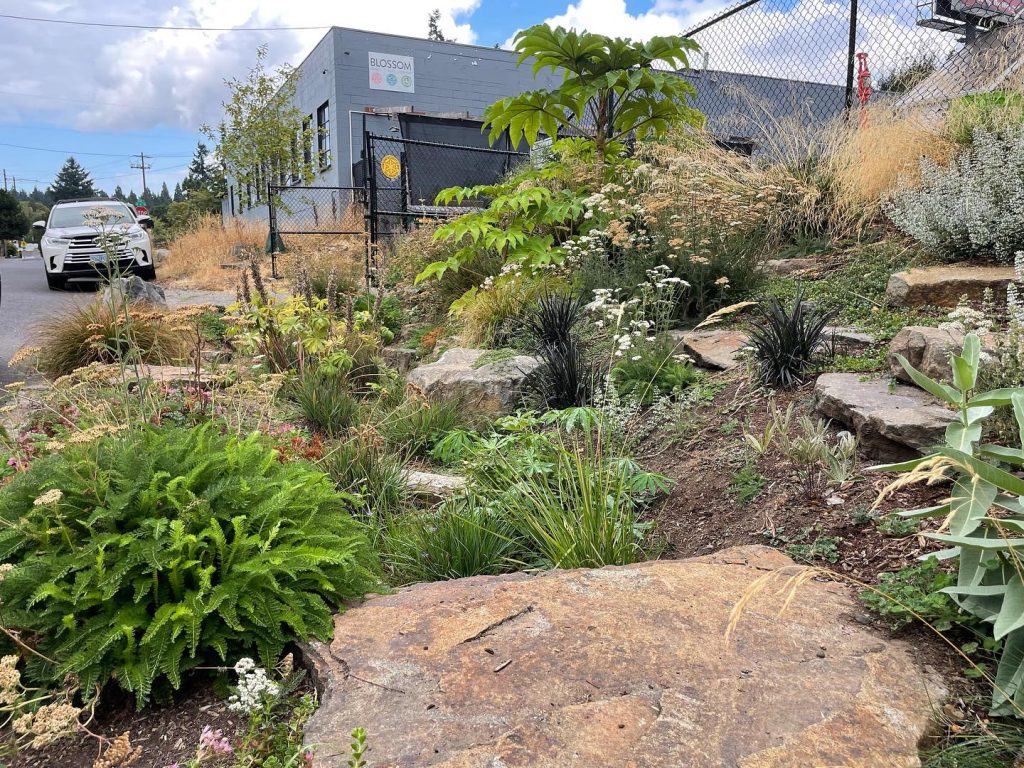
Pollinator-friendly rain borders are an excellent way to manage rainwater while supporting local wildlife. These borders are designed to capture and absorb runoff while providing essential habitats for pollinators like bees, butterflies, and hummingbirds. By selecting native plants that thrive in wet conditions, you can create a beautiful and functional landscape.
To create a rain border, define the area where you want to capture runoff and prepare the soil accordingly. Choose a mix of native plants that bloom at different times throughout the year, ensuring a consistent food source for pollinators.
Incorporate decorative stones or logs to add visual interest and provide additional habitats. A pollinator-friendly rain border not only manages rainwater effectively but also fosters biodiversity and creates a vibrant outdoor space that supports the environment.
10. Use Gravel Mulch Beds for Drainage Zones

Gravel mulch beds are an effective way to manage drainage while enhancing the aesthetics of your garden. These beds help to absorb rainwater, reduce runoff, and prevent soil erosion, making them a smart choice for homeowners looking to promote sustainability in their landscaping.
To create a gravel mulch bed, start by selecting an area where drainage is an issue. Clear the space of grass and weeds, then lay down landscaping fabric to prevent weed growth.
Fill the area with a mix of gravel and decorative stones to create a visually appealing surface. You can even incorporate drought-tolerant plants and shrubs for added beauty and functionality.
Gravel mulch beds are low-maintenance, stylish, and efficient, making them an excellent addition to any rainscaping project.
11. Border Your Garden with a French Drain
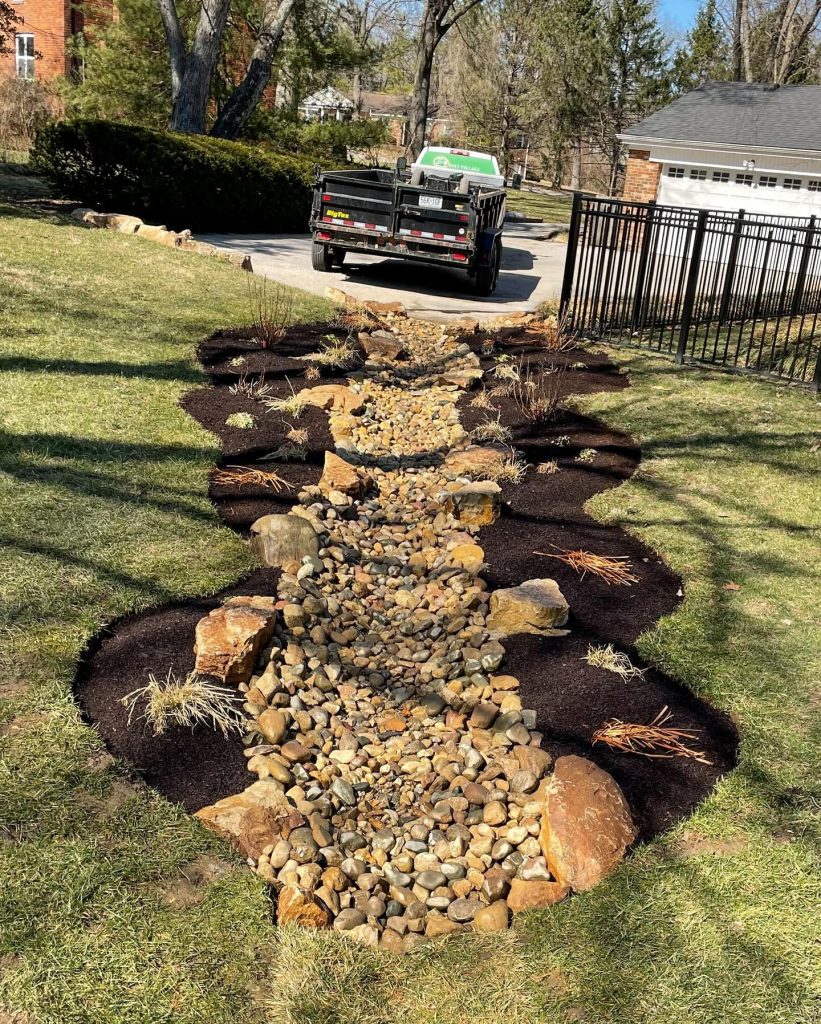
A French drain is a versatile drainage solution that effectively redirects water away from areas prone to flooding or standing water. This system consists of a trench filled with gravel and a perforated pipe at the bottom that collects and channels water away from your garden. A well-designed French drain can prevent water from pooling near your foundation or in your garden beds, protecting both your plants and your home.
To install a French drain, start by digging a trench at least 6 inches wide and deep enough to accommodate the gravel and pipe. Ensure that the trench has a slight slope, allowing water to flow naturally toward a designated drainage area, such as a dry creek bed or rain garden.
Fill the bottom of the trench with a few inches of gravel, then place the perforated pipe on top, ensuring the holes are facing downward. Cover the pipe with more gravel before adding landscaping fabric to keep soil from mixing with the gravel. Finally, fill the trench with soil and sod or decorative stones to blend it into your landscape design.
A French drain not only helps manage rainwater but also adds an organized look to your garden while protecting your home from water damage.
12. Use Raised Planting Mounds for Style and Drainage
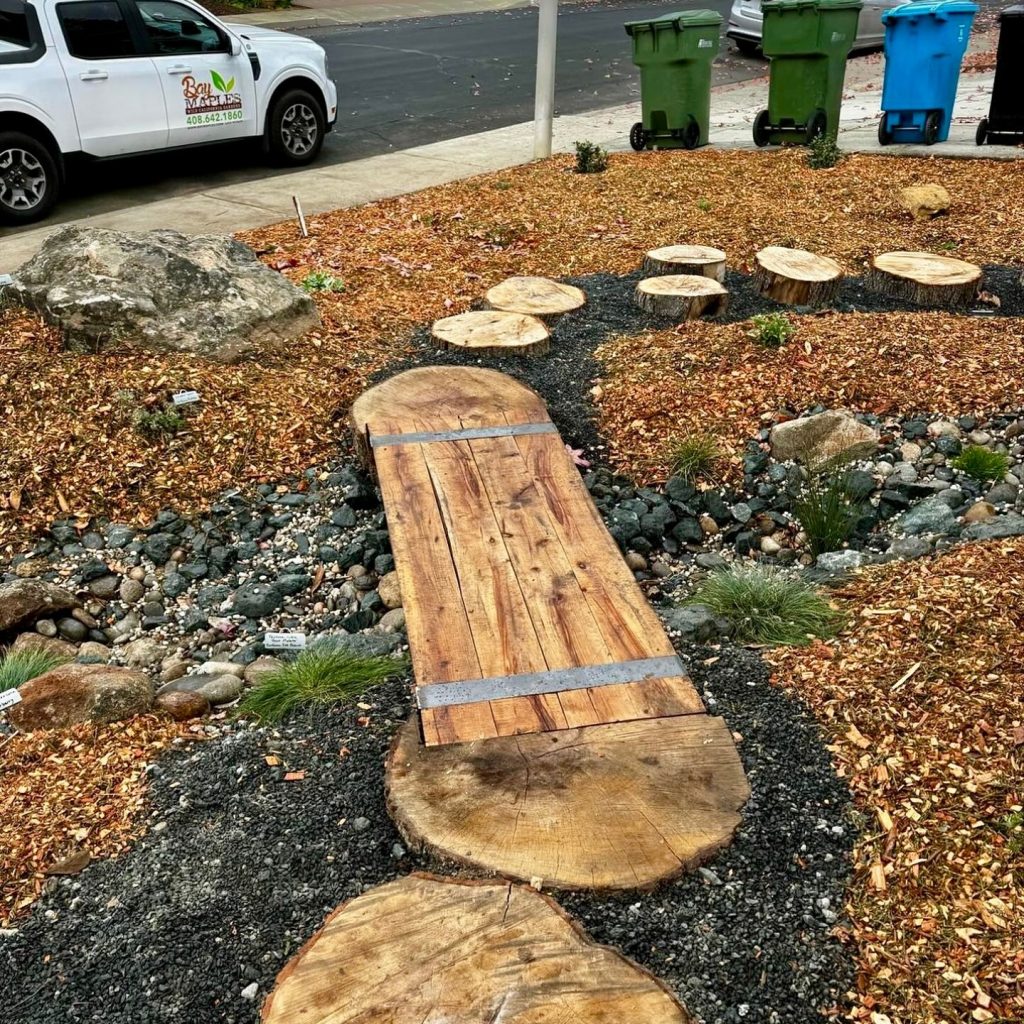
Raised planting mounds are an effective way to improve drainage in your garden while adding height and visual interest to your landscape. By creating elevated planting areas, you can prevent water from pooling around your plants, ensuring they receive adequate drainage during heavy rains.
To create raised planting mounds, choose well-draining soil and organic matter to build up the height. Shape the mounds to suit your design preferences—rounded, oval, or even tiered for added dimension. Plant a variety of flowers, herbs, or vegetables in the mounds to create a lush and vibrant garden.
In addition to their functional benefits, raised mounds can serve as focal points in your landscape design. Consider adding decorative borders made of wood, stone, or brick to define the mounds and enhance their aesthetic appeal.
Raised planting mounds not only help with drainage but also provide a unique and attractive way to showcase your favorite plants, making them a beautiful addition to any rainscaping project.
13. Incorporate a Mini Wetland or Rain Pond
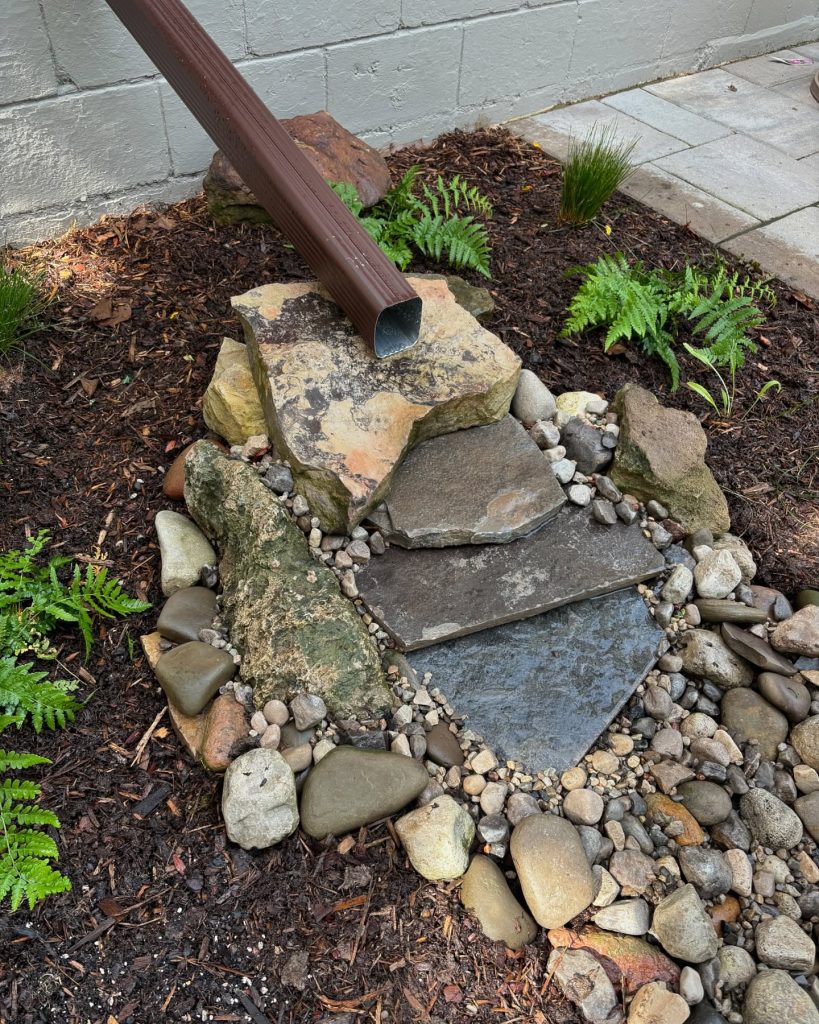
Creating a mini wetland or rain pond can be an exciting way to manage excess rainwater while providing a habitat for wildlife. These water features can enhance your garden’s biodiversity, attracting frogs, birds, and beneficial insects that contribute to a healthy ecosystem.
To create a mini wetland, select a low area in your yard where water tends to collect. Dig a shallow pond, ensuring it has gently sloping sides to allow animals to access the water easily. You can line the pond with natural materials like stones or plant native wetland plants around the edges to create a seamless transition between land and water.
Incorporate a variety of aquatic and marginal plants, such as cattails, sedges, and water lilies, to provide shelter and food for wildlife. Additionally, consider adding a small fountain or waterfall to keep the water aerated and create soothing sounds in your outdoor space.
Mini wetlands and rain ponds not only manage rainwater effectively but also offer a serene retreat where you can enjoy nature’s beauty.
14. Edge with River Rocks for Natural Runoff Control
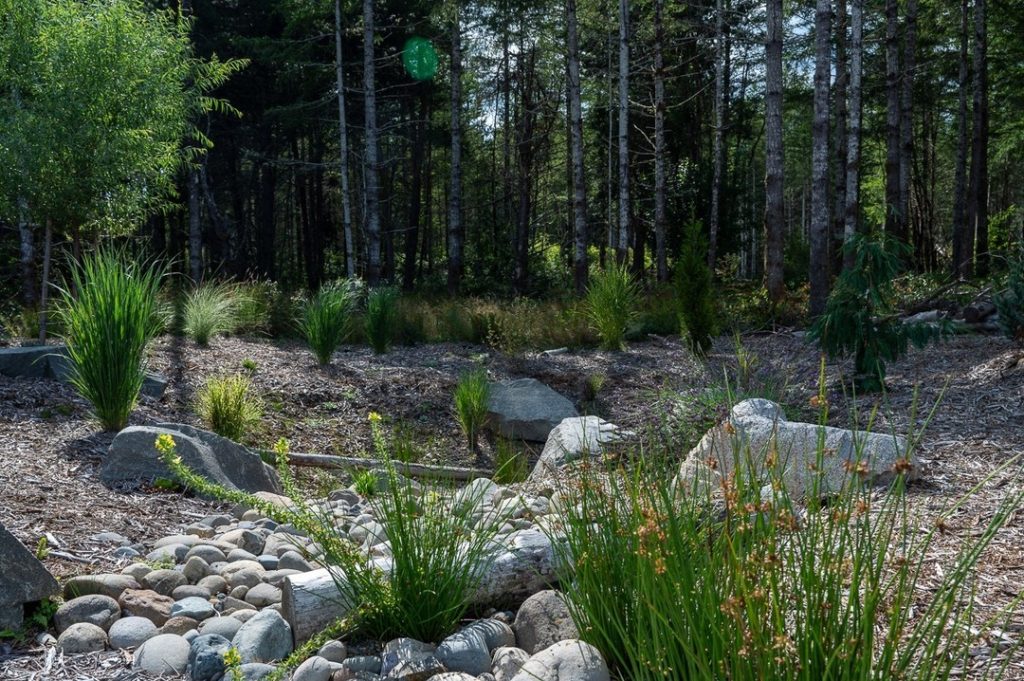
River rocks are a stylish and functional addition to any landscape, serving as a natural solution for managing runoff and preventing erosion. By strategically placing river rocks along garden edges, pathways, or around trees, you can create a visually appealing barrier that directs water flow while enhancing your garden’s aesthetic.
To incorporate river rocks into your landscape, start by selecting an area where runoff is a concern. Clear the space of debris and weeds, then lay down landscaping fabric to prevent weeds from growing through the rocks.
Arrange the river rocks in a way that channels water toward designated drainage areas, such as a rain garden or dry creek bed. You can mix different sizes and colors of river rocks to create a visually interesting design while promoting proper drainage.
Using river rocks not only helps manage runoff but also adds texture and color to your garden, making it a popular choice for eco-friendly landscaping.
15. Add a Rain-Resistant Fence or Trellis
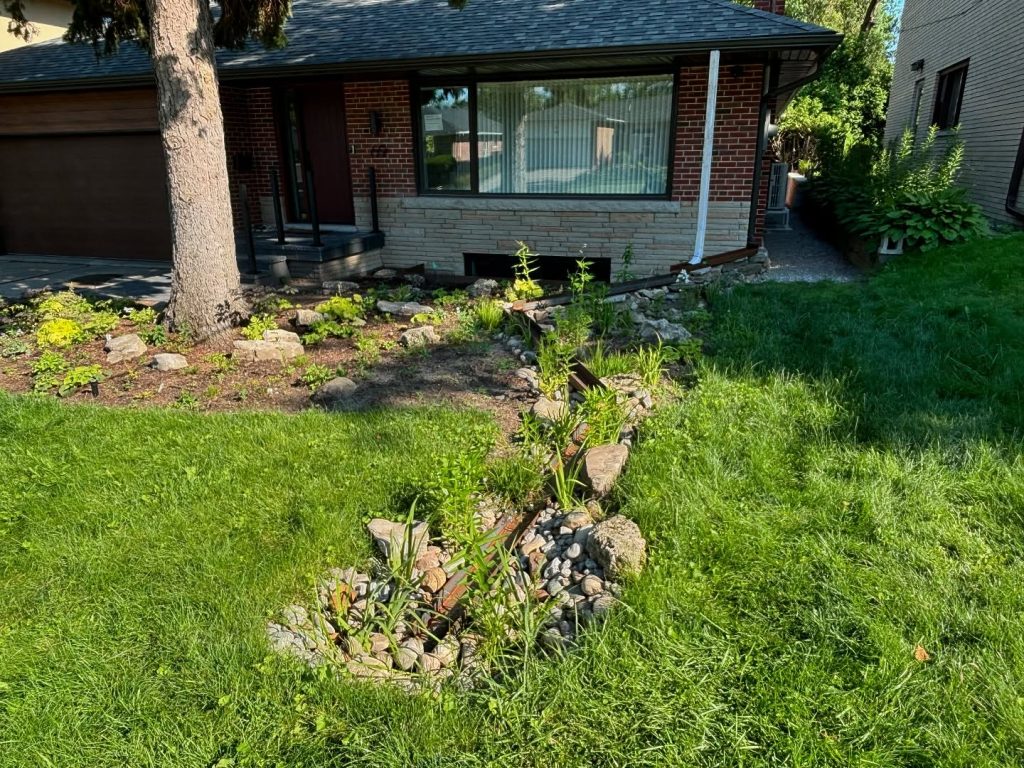
Incorporating a rain-resistant fence or trellis can enhance your landscape’s aesthetics while managing rainwater effectively. These structures can provide shade, support climbing plants, and help redirect rainwater away from your home and garden beds.
When choosing materials for your fence or trellis, consider using rot-resistant wood, composite materials, or metal that can withstand the elements. Design the structure to allow for adequate airflow and light for the plants you want to grow.
Position your fence or trellis strategically to catch rainwater and redirect it toward desired areas, such as a rain garden or a dry creek bed. Additionally, plant climbing vines or flowers along the trellis to create a beautiful living wall that thrives in wet conditions.
A rain-resistant fence or trellis not only serves as a functional element for managing rainwater but also adds height and visual interest to your outdoor space.
16. Combine Rainscaping Elements for a Full System
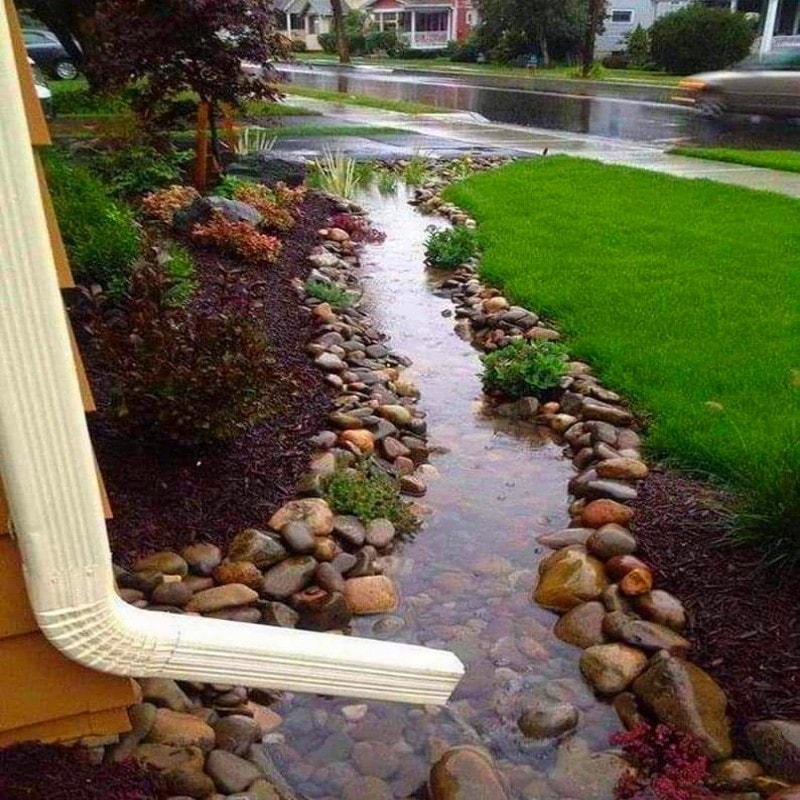
One of the most effective ways to manage rainwater is by combining multiple rainscaping elements into a cohesive system. By integrating features such as rain gardens, dry creek beds, permeable pavers, and rain barrels, you can create a comprehensive approach to handling excess water while enhancing the beauty of your landscape.
Start by assessing your yard’s unique drainage patterns and identifying areas where water tends to accumulate. From there, develop a plan that incorporates various rainscaping techniques to address these issues. For example, you might position a rain barrel to collect runoff from a roof, direct overflow to a rain garden, and channel excess water through a dry creek bed.
Consider creating a layout that promotes both function and beauty by incorporating plants, decorative stones, and pathways to tie the elements together. This holistic approach not only improves drainage but also creates a visually stunning outdoor environment that reflects your personal style.
Combining rainscaping elements allows you to manage rainwater effectively while creating an attractive and functional landscape.
17. Incorporate Native Plants for a Sustainable Landscape
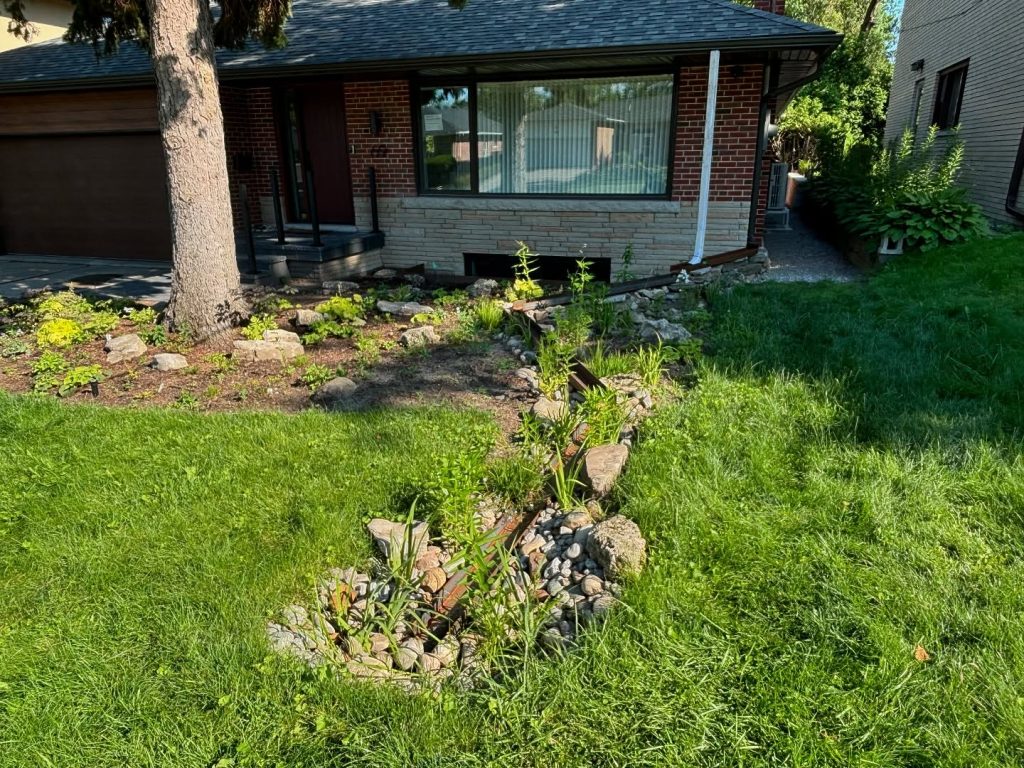
Native plants play a crucial role in rainscaping, offering numerous benefits for both your garden and the environment. These plants are naturally adapted to your local climate, require less water, and provide essential habitats for wildlife, making them an excellent choice for sustainable landscaping.
When selecting native plants for your rainscaping project, consider species that thrive in wet conditions and are well-suited to your region. These plants can help absorb excess rainwater, improve soil quality, and reduce the need for chemical fertilizers or pesticides.
Incorporate a variety of native flowers, shrubs, and grasses to create a diverse and visually appealing landscape. You can design your garden to bloom at different times throughout the year, ensuring continuous color and interest.
By incorporating native plants into your rainscaping efforts, you can create a beautiful and sustainable landscape that benefits both your home and the surrounding ecosystem.
Conclusion
Rainscaping offers an incredible opportunity to create beautiful, functional outdoor spaces while promoting sustainability and responsible water management. From rain gardens and decorative rain barrels to mini wetlands and native plant borders, the 17 rainscaping ideas presented in this article provide a wealth of inspiration for homeowners looking to enhance their landscapes.
By implementing these ideas, you can effectively manage rainwater runoff, reduce flooding, and create a thriving habitat for local wildlife. Whether you choose to start small with a decorative rain barrel or embark on a more comprehensive project that includes multiple elements, every step toward rainscaping contributes to a healthier environment.
Embrace the beauty and functionality of rainscaping in your yard, and enjoy the benefits of a sustainable landscape that you can cherish for years to come. Happy gardening!
